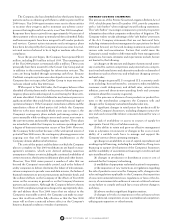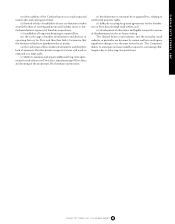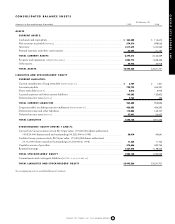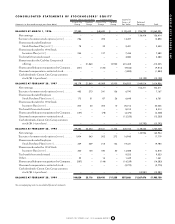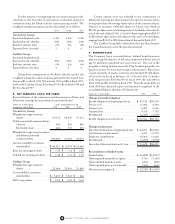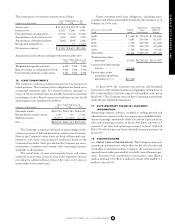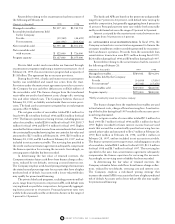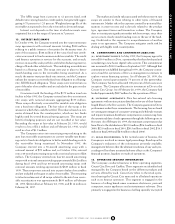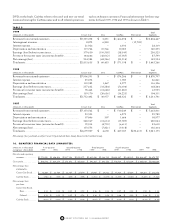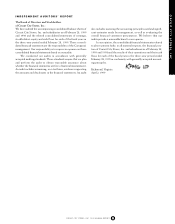CarMax 1999 Annual Report Download - page 39
Download and view the complete annual report
Please find page 39 of the 1999 CarMax annual report below. You can navigate through the pages in the report by either clicking on the pages listed below, or by using the keyword search tool below to find specific information within the annual report.
In May 1995, the Company entered into a five-year,
$175,000,000, unsecured bank term loan. Principal is due in full at
maturity with interest payable periodically at LIBOR plus 0.35
percent. At February 28, 1999, the interest rate on the term loan
was 5.67 percent.
In June 1996, the Company entered into a five-year,
$130,000,000, unsecured bank term loan. Principal is due in full at
maturity with interest payable periodically at LIBOR plus 0.35
percent. At February 28, 1999, the interest rate on the term loan
was 5.29 percent.
The Company maintains a multi-year, $150,000,000, unse-
cured revolving credit agreement with four banks. The agreement
calls for interest based on both committed rates and money mar-
ket rates and a commitment fee of 0.13 percent per annum. The
agreement was entered into as of August 31, 1996, and terminates
August 31, 2002. No amounts were outstanding under the revolv-
ing credit agreement at February 28, 1999 or 1998.
The Industrial Development Revenue Bonds are collateral-
ized by land, buildings and equipment with an aggregate carrying
value of approximately $10,740,000 at February 28, 1999, and
$10,879,000 at February 28, 1998.
In November 1998, CarMax entered into a four-year, unse-
cured $5,000,000 promissory note. Principal is due annually with
interest payable periodically at 8.25 percent.
In fiscal 1999, CarMax entered into a $200,000,000 one-
year, renewable inventory financing arrangement with an asset-
backed commercial paper conduit. The arrangement will provide
funding for the acquisition of vehicle inventory through the use of
a non-affiliated special purpose company. During fiscal 1999, no
inventory was financed by CarMax under this arrangement.
The scheduled aggregate annual principal payments on long-
term obligations for the next five fiscal years are as follows: 2000 -
$2,707,000; 2001 - $177,344,000; 2002 - $132,485,000; 2003 -
$102,594,000; 2004 - $1,507,000.
Under certain of the debt agreements, the Company must
meet financial covenants relating to minimum tangible net worth,
current ratios and debt-to-capital ratios. The Company was in
compliance with all such covenants at February 28, 1999 and 1998.
Short-term debt is funded through committed lines of credit
and informal credit arrangements, as well as the revolving agree-
ment. Amounts outstanding and committed lines of credit avail-
able are as follows:
Years Ended February 28
(Amounts in thousands)
1999 1998
Average short-term debt outstanding ........... $ 54,505 $ 48,254
Maximum short-term debt outstanding........ $463,000 $414,000
Aggregate committed lines of credit............. $370,000 $410,000
The weighted average interest rate on the outstanding short-
term debt was 5.1 percent during fiscal 1999, 5.7 percent during
fiscal 1998 and 5.4 percent during fiscal 1997.
The Company capitalizes interest in connection with the
construction of certain facilities and software developed or
obtained for internal use. In fiscal 1999, interest capitalized
amounted to $5,423,000 ($9,638,000 in fiscal 1998 and
$6,970,000 in fiscal 1997).
6. INCOME TAXES
The Company files a consolidated federal income tax return. The
components of the provision for income taxes are as follows:
Years Ended February 28
(Amounts in thousands)
1999 1998 1997
Current:
Federal ......................................... $59,134 $46,475 $55,673
State............................................. 7,833 2,406 6,964
66,967 48,881 62,637
Deferred:
Federal ......................................... 20,013 12,801 19,839
State............................................. 619 2,251 1,134
20,632 15,052 20,973
Provision for income taxes................ $87,599 $63,933 $83,610
The effective income tax rate differed from the Federal statu-
tory income tax rate as follows:
Years Ended February 28
1999 1998 1997
Federal statutory income
tax rate............................................. 35.0% 35.0% 35.0%
State and local income taxes,
net of Federal benefit....................... 3.0%3.0%3.0%
Effective income tax rate...................... 38.0% 38.0% 38.0%
In accordance with SFAS No. 109, the tax effects of tempo-
rary differences that give rise to a significant portion of the
deferred tax assets and liabilities at February 28, 1999 and 1998,
are as follows:
(Amounts in thousands)
1999 1998
Deferred tax assets:
Deferred revenue ........................................ $ 8,332 $ 1,360
Inventory capitalization.............................. 2,578 4,976
Accrued expenses........................................ 27,080 42,554
Other .......................................................... 5,430 3,638
Total gross deferred tax assets................. 43,420 52,528
Deferred tax liabilities:
Depreciation and amortization ................... 48,035 45,118
Gain on sales of receivables......................... 14,990 11,439
Other prepaid expenses .............................. 12,062 10,569
Other .......................................................... 15,758 12,195
Total gross deferred tax liabilities........... 90,845 79,321
Net deferred tax liability................................... $47,425 $26,793
Based on the Company’s historical and current pretax earn-
ings, management believes the amount of gross deferred tax assets
will be realized through future taxable income; therefore, no valu-
ation allowance is necessary.
CIRCUIT CITY STORES, INC.
CIRCUIT CITY STORES, INC. 1999 ANNUAL REPORT 37



